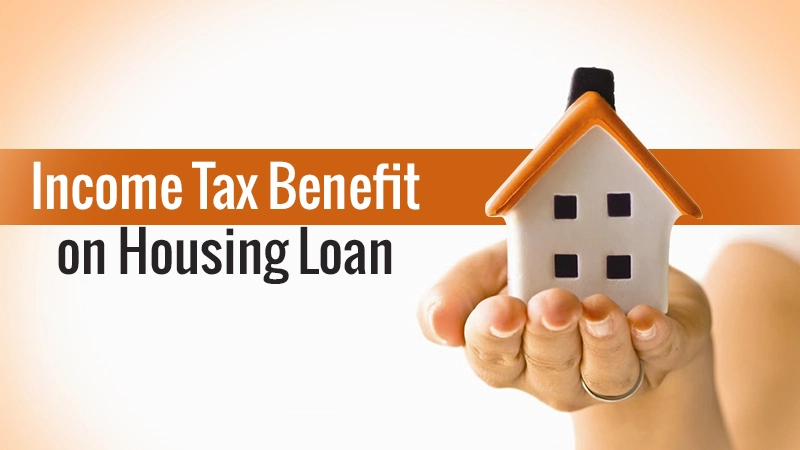Table of Content
On purchase of property with home loans, borrowers enjoy a variety of deductions on their income tax liability. These deductions against the tax could be claimed under four sections of the income tax act, namely Section 80C, Section 24, Section 80EE and Section 80EEA. In this article, we will discuss at length how these sections help a home buyer enjoy the various tax rebates.
Why does the govt offer tax benefit on home loan?
Owning property entails the obligation to pay taxes, and as a result, an individual's income from a house property is subject to taxation, reflecting its potential rental earnings even if unoccupied. Nevertheless, the government provides several tax advantages to enhance the attractiveness of property purchases, particularly when financed through a home loan. Acquiring a property with housing finance presents additional advantages, allowing individuals to become homeowners sooner than if they solely relied on their savings.
Home loan tax benefits 2024
Homebuyers enjoy income tax benefits on both, the principal and interest component of the home loan under various sections of the Income Tax Act 1961.
| Tax deductions allowed on home loan principal + stamp duty registration charge | |
| Relevant Section/s in the income tax law | Section 80C |
| Upper limit on tax rebate | Rs 1.50 lakhs per annum |
| Upper limit on tax rebate for senior citizens | Rs 2 lakhs per annum |
| Tax deductions allowed on home loan interest | |
| Relevant Section/s in the income tax law | Section 24, Section 80EE, Section 80EEA |
| Upper limit on tax rebate | Up to Rs 3.50 lakhs per annum |
| Upper limit on tax rebate for senior citizens | Up to Rs 4.50 lakhs per annum |
Also Read: Home Loan Benefits to Women and Joint Borrowers
Deductions allowed on home loan principal
Section 80C Deduction
Available for: Property construction, property purchase
Can be claimed for: Self-occupied, rented, deemed-to-be-rented properties
Under Section 80C, around twelve investments or expenditures, such as contributions to the provident fund, public provident fund, life insurance premiums, home loan principal, and expenses like stamp duty and registration charges for property acquisition, are eligible for tax exemption. However, an individual taxpayer is limited to claiming a maximum deduction of Rs 1.50 lakhs per year under Section 80C.
In fact, industry body CREDAI has suggested that in Budget 2021, the deduction limit under Section 80C for principal repayment on home loans be increased, to make the provision more exhaustive.
According to Amit Modi, director of ABA Corp and president-elect, CREDAI Western UP, the deduction of principal amount on housing loan should not be clubbed with other deductions under Section 80C. “The deduction should be allowed separately, over and above the limit of Rs 1.50 lakhs under Section 80C. The limit under Section 80C should also be increased to Rs 3 lakhs in the Budget 2021,” Modi said.
In light of the fact that our first tax-saving preferences are investment assets such as PF, PPF and life insurance policies at the start of our working careers, a middle-class tax payer typically exhausts this rebate limit much before they actually invest in a property.
Even if that is not the case and there is some scope for the tax payer to claim benefits towards home loan principal payment, it would be quite limited.
For example: If you are depositing Rs 50,000 a year in your PPF account (the upper limit here is Rs 1.50 lakhs a year) and pay another Rs 50,000 as you insurance policy premium (the minimum premium is Rs 20,000 per annum), you can only claim Rs 50,000 from your home loan interest payments under Section 80C, even if the annual outgo if much higher.
This is why there has been a long-standing demand that the deduction limit under Section 80C be increased, in order to justify the vast number of investment/expenditures it covers.
Terms and conditions for home buyers to avail of benefits under Section 80C |
| 1. If you have taken loan to build a home, the construction work should be completed within 5 years of taking the home loan. |
| 2. The house should not be sold within 5 years of possession. In case that happens, any deductions that you have claimed will be added back to your income and taxed accordingly, in the assessment year in which the sale takes place. |
| 3. Deductions under Section 80C are offered on the payment basis – deductions can only be claimed on the actual amount the borrower pays in a year. |
How to maximise tax rebate under Section 80C?
In the case of joint property ownership, each co-borrower has the opportunity to avail a tax deduction of Rs 1.50 lakhs on their individual incomes under Section 80C. For spouses to be eligible for this benefit, they must be both co-owners and co-borrowers.
Also Read: 5 Ways to pay home loan faster
Deductions allowed on home loan interest
Deductions for home loan interest repayment are offered under various sections of the income tax law.
Deductions under Section 24 (B)
Available for: Property construction, property purchase
Can be claimed for: Self-occupied, rented, deemed-to-be-rented properties
Under Section 24, individuals purchasing homes can claim deductions of up to Rs 2 lakh annually towards interest payments. However, this limit applies exclusively to self-occupied properties. If the property is rented out or falls into the deemed-to-be-let-out category, the entire interest amount paid qualifies for deduction. In such cases, taxpayers are restricted to offsetting losses up to Rs 2 lakh under the "income from housing property" category annually.
In situations where the loan amount is intended for the construction or acquisition of a new property, the borrower can seek a Rs 2 lakh deduction on pre-construction interest each year. This can be claimed in five equal installments at the beginning of the year in which the property is constructed or purchased.
Terms and conditions for home buyers to avail of benefits under Section 24 |
| 1. If you have taken a loan to build a home, the construction work should be completed within 5 years of taking the home loan. |
| 2. The deduction is capped at Rs 30,000, if the house is not constructed within 5 years of taking the loan. This period starts from the end of the financial year in which the loan is borrowed. |
| 3. The deduction can be claimed from the year in which the construction is completed. |
| 4. The loan should have been taken after April 1, 1999. |
| 5. A certificate from the bank about the interest calculation is required, to claim the benefit. |
| 6. Deductions under Section 24 are offered on accrual basis – interest is calculated for each year separately and the rebate can be claimed even if no actual payment is made. |
Deduction under Section 24 is also available to buyers who do not use home loan
Section 24 permits buyers to claim deductions, even if they have utilized their personal funds for the purchase without relying on a home loan. According to this section, property owners can benefit from a flat 30% deduction on the net annual value of the property if the house is entirely purchased using the buyer's personal funds. It's important to note that this rebate is not applicable to self-occupied properties, as they do not have any net annual value as per current tax laws.
How to maximise tax rebate under Section 24?
If a property is jointly owned, each co-borrower can claim Rs 2 lakhs as tax deduction on their respective incomes under Section 80C. In this case also, all the owners have to be co-borrowers.
Borrowers must also note that if they have paid more than Rs 2 lakhs as interest in a year, they have the option to carry the additional expense forward for another three years, to set off the losses. This option is available to only those property owners who are generating income from the house property.
Also Read: Top 14 Common Reasons for Home Loan Application Rejection by Banks.
Deductions under Section 80EE
Available for: Property purchase
Can be claimed for: Self-occupied, rented, deemed-to-be-rented properties
Introduced in the fiscal year 2013-15 for a duration of two years, Section 80EE was designed to enhance the appeal of home ownership for first-time buyers. It provided an additional rebate on top of the deductions available under Section 80C and Section 24. Initially, the deduction limit under this section was set at Rs 1 lakh. However, upon its reintroduction for the fiscal year 2016-17, the rebate limit was reduced to Rs 50,000 per annum.
Terms and conditions for home buyers to avail of benefits under Section 80EE |
| 1. The purchaser must be a first-time home buyer. |
| 2. The property value must not exceed Rs 50 lakhs and the loan value should be up to Rs 35 lakhs. |
| 3. Deductions can only be claimed if the loan is borrowed from a financial institution. Rebate is not applicable if the loan is borrowed from family members or friends. |
| 4. Tax payer can claim the rebate under Section 80EE only after exhausting the waiver provided under Section 24. |
How to maximise tax benefits under Section 80EE?
New home loan applicants are no longer eligible for this benefit. However, individuals who secured loans during the period when Section 80EE was in effect can retain the advantage of claiming increased benefits throughout the loan tenure. It's noteworthy that Section 80EE doesn't mandate self-occupation of the property to qualify for the rebate, allowing you to also claim the benefit for a rented or deemed-to-be-let-out property.
Deductions under Section 80EEA
Available for: Property purchase
Can be claimed for: Self-occupied, rented, deemed-to-be-rented properties
The then finance minister Piyush Goyal introduced Section 80EEA in the interim budget of 2019, with an aim to make home ownership more lucrative for the first-time buyer, by way of offering an additional deduction of Rs 1.50 lakhs in a year. Benefits under Section 80EEA were extended for another year during the Budget 2020 (up to March 2021).
Owing to the difficulties caused by the Coronavirus pandemic, there was a demand from sector stakeholders, to extend this time limit further, in order to incentivise buyers. Consequently, finance minister Nirmala Sitharaman extended the scope of this section for another year, i.e., till March 31, 2022, to provide an impetus to the sector.
Benefits under Section 80EEA are over and above the ones offered under Section 80C and Section 24. Since the section doesn’t specify the point, it is understood that the benefits under are available for residents, as well as non-residents.
Also Read: How to reduce home loan interest rate?
Terms and conditions for home buyers to avail of benefits under Section 80EEA |
| 1. Deduction is available only to individuals who are first-time buyers. |
| 2. Only those buyers can claim benefits under Section 80EEA who are not claiming deductions under Section 80EE. |
| 3. Property value should not exceed Rs 45 lakhs. |
| 4. Carpet area of the unit is limited to 60 sq metres in mega cities and 90 sq metres in other cities. |
| 5. The loan should have been taken from a bank or housing finance company and not from friends or family members. |
How to maximise tax benefits using Section 80EEA?
New buyers of affordable properties have the opportunity to secure a Rs 3.50 lakh interest deduction by leveraging the advantages provided by both Section 24 and Section 80EEA. Furthermore, in the case of joint ownership, each co-borrower can independently claim the Rs 3.50 lakh per annum tax benefit. Additionally, it's important to note that Section 80EEA does not require the property to be self-occupied, allowing you to avail the rebate for a property that is rented or deemed to be let out.
How much home loan can you get at your current salary?
| Monthly salary | Loan amount you are eligible for | Loan tenure | Loan interest | EMI you will pay |
| Rs 10,000 | Rs 4,78,217 | 20 | 8% | Rs 4,000 |
| Rs 15,000 | Rs 7,17,326 | 20 | 8% | Rs 6,000 |
| Rs 20,000 | Rs 9,56,434 | 20 | 8% | Rs 8,000 |
| Rs 25,000 | Rs 11,95,543 | 20 | 8% | Rs 10,000 |
| Rs 30,000 | Rs 16,13,983 | 20 | 8% | Rs 13,500 |
| Rs 35,000 | Rs 18,82,980 | 20 | 8% | Rs 15,750 |
| Rs 40,000 | Rs 21,51,977 | 20 | 8% | Rs 18,000 |
| Rs 45,000 | Rs 25,20,976 | 20 | 8% | Rs 20,250 |
| Rs 50,000 | Rs 26,89,972 | 20 | 8% | Rs 22,500 |
| Rs 55,000 | Rs 32,87,743 | 20 | 8% | Rs 27,500 |
| Rs 60,000 | Rs 35,86,629 | 20 | 8% | Rs 30,000 |
| Rs 65,000 | Rs 38,85,514 | 20 | 8% | Rs 32,500 |
| Rs 70,000 | Rs 41,84,400 | 20 | 8% | Rs 35,000 |
| Rs 75,000 | Rs 44,83,286 | 20 | 8% | Rs 37,500 |
| Rs 80,000 | Rs 47,82,172 | 20 | 8% | Rs 40,000 |
| Rs 85,000 | Rs 50,81,057 | 20 | 8% | Rs 42,500 |
| Rs 90,000 | Rs 53,79,943 | 20 | 8% | Rs 45,000 |
| Rs 95,000 | Rs 56,78,829 | 20 | 8% | Rs 47,500 |
| Rs 1,00,000 | Rs 59,77,715 | 20 | 8% | Rs 50,000 |
Also Read: The Optimal Home Loan Duration: Choosing Between 10, 20, or 30 Years.



_1758715186.webp)






Ans 1. Tax deduction on the principal component is limited to Rs 1.50 lakhs per annum under Section 80C, while rebate towards interest is capped at Rs 2 lakhs. Additional tax benefits are also offered to first-time home buyers under Section 80EE and Section 80EEA.
Ans 2. Both, the husband and wife, can separately claim deductions of Rs 1.50 lakhs under Section 80C and Rs 2 lakhs under Section 24 while filing taxes, as long as they are co-borrowers as well as co-owners of the property.
Ans 3. The buyer claims tax deduction towards interest payment, only after the completion of construction. After taking possession of the unit, the buyer can claim the entire outgo in five equal installments.
Ans 4. In such a case, deductions can only be claimed towards the interest component under Section 24. The person from whom you borrow the capital, would also be obliged to issue you an interest certificate, based on which your deduction claim would be accepted. The lender’s interest income would also be taxed, based on this document.
Ans 5. Deductions can be claimed under Section 80C of the Income Tax Act on stamp duty and registration charge paid on home purchase, under the overall limit of Rs 1.50 lakhs per annum. This claim can, however, be made only in the year when the property was purchased.
Ans 6. A tax payer can claim home loan tax benefits along with house rent allowance in two scenarios. A: he is paying EMI for an under-construction project. B: he is living in a rented accommodation while his own property is also let out. In the latter scenario, his income from house property would be taxable.
Ans 7. The tax break is shared by each party in proportion to his contribution towards the EMI repayment.
Ans 8. Yes, you claim deductions on two home loans within the specific limit under Section 24 (Rs 2 lakhs per annum) if the properties are self-occupied. Only for your first home, you can claim benefits under either under Section 80EE or 80EEA. For your second home, no deduction is available on the principal payment.
Ans 9. Almost all banks offer online calculators that help borrowers arrive at the amount they can claim as income tax rebate. You will have to key in details such as loan amount, loan tenure, interest rate, annual income, etc., while using the online calculator.
Ans 10. Your lender issues you a certificate each year, specifying the amount you pay every year as principal and interest component of the loan home. The tax payer has to submit this certificate, to claim deductions.
Ans 11. Only first-time buyers can claim deductions under Section 80EE and Section 80EEA. This helps them make their combined deductions as high as Rs 5 lakhs per annum. The benefit will double, if the property is jointly owned.